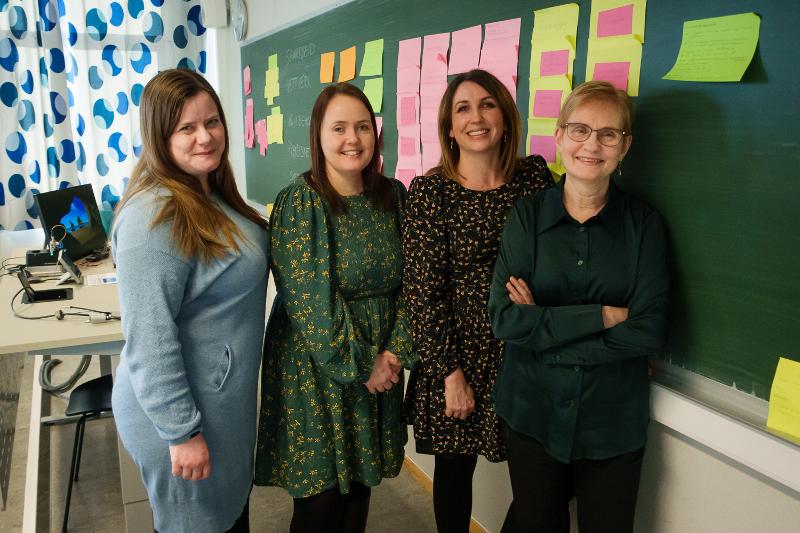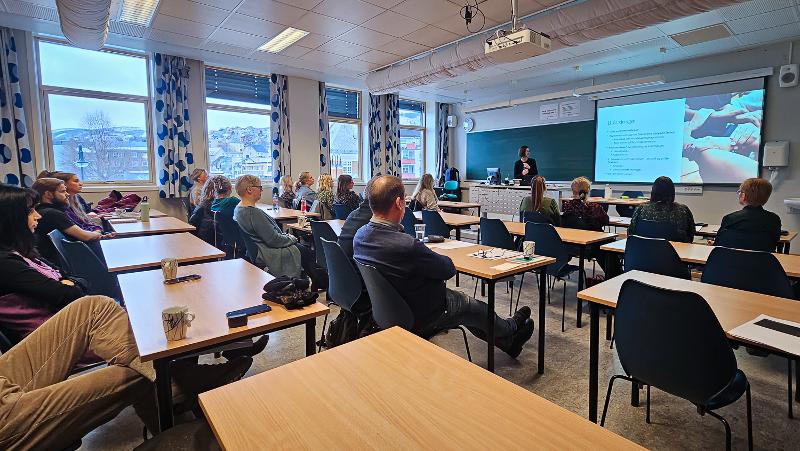Better Collaboration Leads to Better Integration
Closer collaboration among everyone working with refugees was perhaps the most important common denominator that emerged, when Harstad Municipality and HealthIntro invited to a dialogue seminar on the International Women's Day.
By: Jan Fredrik Frantzen, communications advisor at UiT

29 employees from the refugee service, health services, the Norwegian Labour and Welfare Administration, and the voluntary sector had set aside March 8th to do an important piece of work. They were to contribute to ensuring that refugees coming to Harstad would receive a better introduction to Norway and the municipality upon their arrival.
The organizers, the integration unit of Harstad Municipality, were very pleased with both the attendance and the outcome.
- We are very satisfied, there was a lot of engagement among the participants today. We all want the same thing; a better service for those who come to Harstad, says Marianne Vikan from the integration unit.
Participating in a Research Project
Harstad Municipality, along with Senja and Sør-Varanger, are three Northern Norwegian municipalities participating in the research project HealthIntro, and the largest of the three was the first out to arrange a dialogue seminar in the project.
The goal of the day was to discuss preliminary findings from the project, such as the lack of coordination between various public services, and to find good solutions for Harstad regarding refugees with health challenges.
- It is incredibly important work to put on the agenda. Everyone has a health, and it matters for how one integrates into society, explains Anja Eliassen Borlaug who leads the integration unit in Harstad.
Single point of entry
More and better collaboration was the overarching theme at the seminar. Several participants expressed that it was good to finally meet in the same room, and that alone would make it easier to collaborate going forward.
- It's important that the public services facilitate interventions so that the refugees can achieve the goals they set in the introduction program. We need more collaboration, and we received many good suggestions today, says Borlaug.
Anne-Torill Drønen, public health nurse in the integration unit, emphasizes that a lot is working well already today, even though many suggestions for improvement came up at the seminar.
- A lot of things are good, but everyone agreed that we have some way to go. Here in Harstad, for example, we are fortunate to have gathered all the services for refugees in one unit and one building.
It is up to the Norwegian municipalities themselves how they want to organize the work with the introduction program and the settlement of refugees. In Harstad, they have chosen co-location as one measure to achieve better collaboration and interaction between the refugee service and the health service.
- Before, it could feel like the refugees were being sent from door to door, but since 2021 we have been in the same place. We actually have a single point of entry, and it greatly helps the collaboration with those working in the health services, explains Marianne Vikan.

Good Collaboration with the Labour and Welfare Administration
Another area where Borlaug, Vikan, and Drønen see that the collaboration works well today is in contact with the Norwegian Labour and Welfare Administration (NAV). One of the goals of Norwegian integration policy is that refugees should enter work during or after the introduction program, and then it is especially important that the collaboration between the refugee service and NAV works well.
The integration unit has also used measures such as mentorship grants and temporary wage subsidies in collaboration with NAV, in order to strengthen the connection to the labor market.
- NAV is very important for getting people into jobs, regardless of health challenges. Here in Harstad, we have achieved a good collaboration with them, and that is very good. In recent years, we have had between 50 and 60 percent who have completed the introduction program and moved on to work or education, Borlaug continues.
Mentorship Program
So where does the path forward for integration work in Harstad lead? The leader of the integration unit wants to further develop interdisciplinary teams and collaborate more closely with other service areas and the volunteer coordinator in the municipality.
Establishing a mentorship program was also highlighted as a possible measure during the dialogue seminar.
- I also want to look at building networks for the refugees, and we will take a closer look at the suggestions to establish a mentorship program for the refugees that we have in the introduction program. I have thought about it before, but we have not proceeded with it. Maybe the time is right for that, she concludes.

This is the Introduction Program for Refugees in Norway
The Introduction Program is a training program designed to prepare refugees for participation in the Norwegian labor market. All refugees between the ages of 18 and 55 who come to Norway are required to participate in the Introduction Program. The same applies to family members who arrive in the country later.
Through the Introduction Program, participants will learn Norwegian and gain an understanding of Norwegian society. They will receive training and knowledge about the Norwegian labor market. They will also receive education if they need it. The goal is for participants to find employment or education upon completion.
The Introduction Program should start as quickly as possible, and no later than three months after the refugees are settled in a municipality.
The Introduction Program is full-time.
HealthIntro – A Research Project on the Introduction Program for Refugees
Health challenges are a significant reason why not all refugees complete the Introduction Program, and why they also fail to find paid employment after the program ends. This can lead to increased inequality and social exclusion. Women seem particularly vulnerable to this.
In the HealthIntro project, we aim to generate knowledge and expertise that can be used in development work in municipalities and at NAV. The goal is to improve conditions for refugees with health challenges in the Introduction Program and to enhance their chances of success in the labor market and society.
The project is funded by the Research Council of Norway (NRC).